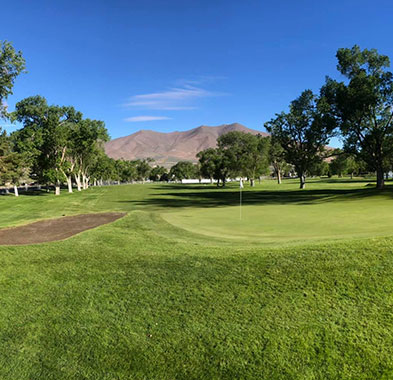We are starting the Teaching Corner with articles by Fred Elliot. Fred Elliott is a PGA Teaching Professional at Hidden Valley CC,
Reno, NV. He can be reached by email at This email address is being protected from spambots. You need JavaScript enabled to view it. or by phone for booking lessons. (775) 544-9812 (call or text)
The teaching corner is open to all teaching professionals in the area. To contribute to this page email me This email address is being protected from spambots. You need JavaScript enabled to view it.
A Couple Routes to Fewer Putts
In the last few years, much of the emphasis from sports psychologists and sports scientists has been on how we can improve our practice. Here are a couple suggestions that could help transfer our work on the practice green to the greens on the course.
Drills that emphasize multiple repetitions from varied distances and angles certainly are necessary at the beginner level and can help solidify an experienced player putting skills. However, there may be an additional exercise that could even fine tune the putting of an advanced player. The goal would be to apportion one's available practice time more efficiently. To achieve this, record during each round you play the length of your first putt on each green. Then sort them into categories such as under 10', 11'-25', and over 25'. Putts 3' or less don't count; if you miss one of these, it is because you did not treat it with the respect (normal pre-shot routine) that you treat longer putts. Add up the number of attempts in each category and apportion your practice time accordingly. You may also discover that an excessive number of putts in one category could reveal an area in your game that needs work. For instance, a high number of putts in the 11'-25' range could mean chipping and pitching should be addressed.
Second, here's an idea that can improve our ability to aim the face of the putter. We know the face dictates 85-90% of the line the putt will start on. We also know an 8-ft putt can be missed if the line is just l1/3 degrees off, even if the path of the putter head was right on track. Try this exercise that will eliminate most variables and enable your athletic skills to fine-tune your aim.
It's important to repeat good fundamentals to hit solid putts, but starting the putt on an exact line is the job of the subconscious - just like it is in such endeavors as firearm target practice, shooting free throws, or throwing a baseball pitch to a specific part of the plate. We are not thinking mechanics, we are letting our athletic skills take over.
Select a straight, flat putt of 8'-10' and putt repeatedly from this distance. Do something to make it as much a "game-situation" as possible. Set a goal of making 2 in a row as many times as possible or keep track of your percentage of makes-just to mention a couple. Making a "game" of it will increase its effectiveness.
Here's hoping these suggestions will fine tune your putting and create that handicap reduction you've been looking for.
Learn the Swing Backwards
Learning to swing a golf club has been described by golfers and non-golfers alike as a very difficult (if not the most difficult) athletic maneuver to learn. The fact that almost every muscle and joint in the body is working in the 2 seconds (1.2 from address to impact) it takes to complete a swing tells part of the tale. Trying to consciously direct the club in this brief period would be difficult for a mongoose, much less a less-speedy human being. Making things more difficult is the fact that because things are happening so quickly we do not feel what's happening in real time. For instance, what we sense happening at impact usually is occurring at a later point in the swing.
There is one way to gain an advantage in this battle-that is "to learn the swing backwards". Simply put this means making your goal a balanced, fundamentally sound finish. You force yourself to have to perform movements prior correctly. We have created a "catch-22" situation to have a solid finish what happens mechanically (particularly from the top of the backswing until impact) before impact must be technically sound. Consciously coordinating weight shift, hip turn, arms to the slot etc. in a brief portion of a second is humanly impossible. But give that lightning-quick computer on our shoulders a final goal (a sound finish) and it can do the brain-to-body-parts programming to accomplish it. Part of this programming process is the fact that we have sufficient time to rehearse and/or visualize this position prior to swinging. As we all know to try to interject a conscious thought once the club starts swinging is exceptionally difficult, and usually counter-productive.
There's a bonus here also. By analyzing exactly what position we are in when we finish we may able to detect certain swing faults. For example, the position of the right shoulder at the finish can tell us the path of our club through the hitting area (a real help with the driver since we don't have the benefit of seeing a divot as we do with our iron shots). If our weight is clearly still on our right foot, we may be just "spinning our hips" to start the downswing and not including weight shift in the motion. Another example could be a right shoulder staying "behind" you at the finish could indicate an overly inside path. There are other indicators that reveal other damaging swing faults.
What to do
In your practice sessions make a habit of holding your finish until the ball hits the ground. If you're still getting unsatisfactory ball flight or poor contact, contact your local PGA professional for input as there probably is a backswing issue that he can help you correct. Hold that finish and good shots and low scores will follow!
Fill this Gap Also
Ever since equipment companies started reducing lofts on their irons(today's 8 iron has roughly the loft of a 6 iron years back) to create " more distance" and make that a selling point, a large gap developed in a set of irons. That gap has essentially been filled with a wedge labeled "gap","dual","attack",etc. On the other end 3,4,and 5 irons have been replaced by hybrids with lofts from 21 to 27 degrees. This end has created a glaring gap that is seen in many golfer's sets.
That gap is the area between a player's 3-wood and the longest hybrid. Selecting a stronger hybrid is a difficult matter because getting a hybrid airborne with less than 20 degrees loft requires very high clubhead speed and rather precise contact. This is a limiting factor that also creates directional problems if a player tries to force increased clubhead speed. The gap in distance, for example, can be as extreme as 35 yards. A player my hit his/her 4 hybrid 185 yards and his/her 3-wood 220 yards. The answer to this problem is a Fairway Wood of somewhere between 19 and 21 degrees loft. It is a great implement as its large head has a low cg and a high moi, both factors that noticeable improve height and distance of your shots. It has a longer more flexible shaft that adds quite a bit more distance. Over the years many players' go-to club was a lofted fairway wood, but with the confusion hybrids brought these clubs have become overlooked. It also can be very effective out of less than perfect lies because of all the factors mentioned.
Another recent development that needs addressing is a recent trend in teaching to emphasize impact position and ball contact. Noted teachers such as Bobby Clampett and Adam Young have emphasized this strongly over the past ten years.
An effective way to achieve better ball contact is by practicing hitting one's irons off bare, even "hardpan" lies. It solves the problem athletically, which is the ideal way to learn a new skill. To achieve good contact off thin or "bare" lies the low point of the swing and shaft lean must be correct-two things necessary for solid ball contact. Practicing off such lies will also improve your impact with all clubs.
So now take that lofted fairway wood off a thin lie and birdie that tough par 4 you've always hated.
To Pendulum or not to Pendulum
We often hear that your putting stroke should work like a pendulum. However, if you watch successful putters they are clearly accelerating the putter through the ball. Pendulums don't markedly accelerate. The fine putting instructor Dave Stockton emphasizes "rolling" the ball and he clearly accelerates the putter with an emphasis on the left hand moving the club forward. Yet in commenting on tempo, Stockton states, "move the putter at the same speed back and through". This would imply a pendulum stroke as the upswing for a pendulum takes the same time as the downswing.
Confusing? It certainly seems so. Can we have a little clarity please? Do we have a voice from the wilderness? Yes, we do. Chris Riddoch, an English professor of sports science, explains technically what is happening in plain English.
He explains that the real tempo of a good putting stroke can be measured and the downswing takes one-half the time that the backswing does. In other words the putter is going twice as fast through the ball as it went back. It is true of all length putts, and, interestingly, the elapsed time for all length putts is about the same. The putter is being "driven harder" on longer putts, but amazingly right at impact it is not accelerating. It has reached a constant speed. This could account for why some accomplished putters use the word pendulum to describe their stroke. This also explains why some instructors, including yours truly, describe the stroke as "pendulum-like"; but not a pendulum. Riddoch explains a true pendulum motion is very sensitive to small forces applied to it. Not a good thing for a putting stroke under pressure.
What can we take from this? The old mantra of good tempo being 1 and 2 is not very effective. Something along the lines of 2 counts on the backswing and 1 on the forward swing should be more effective. This also explains the fact that if you look closely good putters almost always have longer follow-throughs than backswings. Keeping both the same is counter-productive.
A good read for a clearer and complete explanation is "Expert Putting" by Chris Riddoch. It just might swing the pendulum towards lower putting numbers.
Junior Golf Notes
Summer is approaching and your junior golfer potentially has a great experience in front of them.
Here are some suggestions that will make that experience a memorable and positive one.
1. Sports scientists and leading national coaches are recommending junior golfers experience at least four or five different sports. Their athletic skills improve and their golf game now has greatly increased potential. The old discussion of "are golfers athletes?" has been replaced by "the better the athlete the better the golfer".
Tiger Woods was the "perfect storm" of circumstances and may be the exception that proves the rule. The modern junior enjoys several sports, but winds up specializing in golf and this background makes him/her a stronger player and person.
2. Make sure your junior has clubs that fit him/her as they grow. Such companies as US Kids and Ping (just to name a few) are making excellent junior equipment that will accelerate your junior's progress. Cut down adult clubs that sometimes would create swing problems are a thing of the past. Some clubs offer a "lease" program that keep the cost reasonable.
3. Here is possibly the most important factor of all. Your energy to see your young one improve can be very positive by providing encouragement, multiple playing opportunities, well-fitted equipment, transportation, etc. and just "being there" for your junior are all very important. Deciding you want to assume the role of a professional instructor can be catastrophic. To begin with, the more talented the golfer the less instruction is required-Juniors take to golf like a duck to water. They are at or approaching their athletic peak and their flexibility and eye-hand coordination are remarkable. All they need is an occasional trip to see their local PGA/LPGA teaching professional. Remember, other than being trained to do the job, he/she has been along that road that your junior is now taking.
One person that never seems to never get credit during Tiger's "perfect storm" was Rudy Duran, the professional that guided Tiger when Tiger was aged 4-9. This period is a very important period in a junior's development. By his own admission, Rudy never did a lot mechanically with Tiger. He already had a great swing. He did, however, teach him many nuances of the game and how to really enjoy the competitive side of golf.
4. Emphasize with the junior that he/she should be having fun. Golf is basically a self starter game. If the junior is having fun, all the hours it takes to become proficient at golf fly by for them. If they show the talent to be competitive or are just enjoying this great game (probably where 95% will wind up) having fun should be the #1 priority.
5. Team Golf. PGA Junior league, high school golf, inter-club matches are factors that are bringing thousands of kids to the golf course. The fun of a team sport is making the game very attractive to kids that might have avoided it before because it seemed like just an individual sport. Juniors of all different skill levels can come together and have a great time on the course.
6. Support First Tee and your local courses' junior golf programs. These emphasize more than just the playing of the game, and are bringing multitudes of better citizens into society.
The Hidden Power Thief
We have all watched or have known a golfer who has a swing that aesthetically and mechanically looks very sound, but hits the ball much shorter than we anticipate. There is a power leak somewhere, but is not evident to even a professional eye.
What do golfers that fall in this group have in common? Usually they are right-handed adults that have taken up golf not as juniors. Doesn't narrow it down much, does it? The one clue is in the fact that one reason juniors take to golf like "ducks to water" is that they have not built up their dominant side as adults have. Their lead side can do its job without the interference that the back side creates. Casting, over the top moves, and generally over activation of the right side are typical faults of adult golfers. Junior golfers who have had either no instruction or a small or moderate amount of professional instruction rarely exhibit these faults.
The culprit for our golfer with the good-looking swing that doesn't seem to create enough distance is excessive tension or pressure in the right hand, arm and shoulder. The adult has spent their life using his/her right side to perform a lot of tasks, many that require a lot of force; unfortunately, this is not one of the sources of power in the golf swing. When we push, shove, throw, or otherwise try to create speed with our right side mayhem ensues. The upper right side has a role in the swing, but it is more of a supportive or bracing role.
What can our shorter-hitting golfer do to gain distance? The first area is grip pressure. Our featured golfer usually exhibits extra tight grip pressure, particularly in the right hand. Hitting balls with as light as pressure as possible with the right hand is the first step. The usually reaction from the golfer is " the club feels like it will fly out of my hands". This is the first clue they are on the right track. If the golfer can overcome the counter-intuitive feel of the soft right hand, they can progressively relax their right arm and shoulder more and more.
Mechanically, the golfer has greatly increased his " conservation of angular movement". In layman's terms, he has maintained the angle between left arm and club as he proceeds in to his forward swing and greatly increased club head speed. The early straightening of this angle was not always evident before because the player's swing was rhythmic and balanced and only close inspection could sometimes expose it. Extra speed is gained as the relaxed right side allows more core speed to also develop. More speed-more distance for our golfer.
For those that are victims of our power thief- swing counter-intuitively and have a well rested right arm and hand to write down more 3's and 4's.
A Couple Power Short Cuts for Seniors and Others
A recurring theme in golf instruction is the idea of coordinating body motion with arm swing. This is certainly important and can be seen very clearly in quality golf swings. However, there does seem to be one common error that derails this process. For the proper sequencing of arms and body to be effective, wrist action has to be very passive-simply allowing the wrists to hinge and unhinge by themselves. A proper grip and grip pressure are important, but if the club is manipulated or strangled by the hands all is for naught. The arms can't swing smoothly in conjunction with the rotating torso because of the interference from the mistiming of this wrist action.
What to do: Here is an exercise that can be done almost anywhere, without a club, and can thwart our tendency to control or over power the club with the hands.
From your normal address position extend your arms with the hands open and the palms 3 to 4 inches apart. Swing the arms back to hip high and forward to hip high, allowing hips and shoulders to turn freely with the arms, keeping the palms apart at all times. At hip high on both sides the arms should finish parallel to the target line. This allows coordinated motion between arms and body with no interference from the hands. Repeat as much as possible; this exercise also has a very positive effect on your pitching.
Second short-cut: As we age, our ability to make a full back-swing is damaged by our diminishing flexibility.
A simple way to retain good backswing rotation is to address the ball with the hips slightly closed. Be very careful to also not close the shoulders; this can adversely affect club path. Giving the hips this slight "head-start" allows the entire torso to rotate more easily during the backswing. Restricting hip-turn has been shown to be counter productive for producing coil in the backswing. The only reminder here is to make sure the right knee remains firm and at least slightly bent.
Give your body a running start with the hips slightly closed; let the arms and body work together as the wrists hinge and unhinge freely (lag?) and feel that remarkable acceleration into impact that just might let a senior reach a par 5 in 2.
Release the Biggest Myth
Of all the myths that have perpetuated themselves over the years the one that is the most persistent and the most deceptive is that of the "release". The definition should give a hint to the truth-"to set free". Nowhere does the definition mention turn, twist, rotate, or square. "Releasing" the club is simply the act of letting the wrists unhinge from approximately hip-high on the downswing through impact. The scientists tell us that swinging the double-pendulum of our left arm and wrist freely creates the most acceleration in the swing. If the wrists have hinged inline with the left arm (flat left wrist at top), when they unhinge the clubface is in roughly the same position at impact as is was at address. The clubface doesn't need squaring, it's been "square" all along. The right hand and wrist does roll over the left, but it doesn't happen until the ball is well on it's way; and the more efficient the release is, the more the wrists simply rehinge. In kinesiological terms, the more efficient the swing the less pronation and supination, and the release is simply radial and ulnar deviation. The added bonus is that the better the path of the swing the more easily and swiftly the wrists unhinge. Sound too technical-in simple terms a neutral grip with the left wrist hinging in line with left arm allows the clubhead to remain square to the path of the club through the swing. There is no opening or closing of the club face-no need to manipulate the clubhead as so many descriptions of the release imply. Yes, there is a complication. A strong grip creates a closed clubface when the wrists hinge; players such as Trevino and Duval played like this, but compensated and got the clubface square at impact by maneuvering the hands well ahead of the ball at impact. Conversely a weak grip would literally require a deceleration so the hands are well behind the ball at impact. The first requires talent and years of hard work to achieve; the second usually doesn't work well at all. Yes, true release is simply letting the clubhead go or be "set free". Thusly, letting go of the concept that the clubhead must be manipulated through impact can free up some more solid hits and release some lower scores.Another Candidate for Hogan's "Secret"Even since Ben Hogan announced his "secret" in an article in LIFE magazine in 1955 avid golfers the world over have speculated over the exact nature of this phenomenon.
Through the years we have heard the secret could be the cupping of the left wrist at the top, the "fanning" of the left wrist on the backswing, the supination of the left wrist at impact, Hogan's incredible concentration, his right leg stability, his transition from backswing to downswing etc. etc. ad infinitum. Probably only the location of the Holy Grail has received more attention.
In our present golf world the term "turn" is heard over and over. Yet, when Hogan talks about the backswing he uses the word somewhat differently. He talks about the "correct order of movement" He emphasized the sequencing of hands, arms, shoulders, and hips. Although he discusses how much the shoulders should outturn the hips, he seems to say the accumulated momentum from the club, hands, and arms are pulling the shoulders and hips around. If we consciously turn shoulders, and/or hips we destroy Hogan's "correct order of movement". Good sequencing is heavily damaged. Is keeping the shoulders and hips passive and being allowed to be pulled around Hogan's secret?
Let's look at a few facts. Obviously, Hogan is known for his incredible accuracy, but he also won several driving contests that were held prior to tour events. Although we greatly admire Snead's huge shoulder turn, Hogan's was almost as big. Yet, when you look at Hogan at the top his lower body screams "stability". He clearly is poised to create a great deal of force with his legs and core to initiate the downswing Is he trying to tell us maximum leverage is created by relaxing shoulders and hips on the backswing, not by consciously twisting and turning them?Although this seems to be another reasonable candidate for the "secret", maybe we are missing what was really Ben's advantage. He seemed, in his own way, to understand the scientific method. He tested concepts with a large number of trials and then put them into the crucible of competition. He did not come to a conclusion first and then do the trials. Recently, we have seen some "reinvent the wheel" swing methods that are thrown out there backed up only by evidence such as selective camera angles and unique assumptions. Give Ben's well-tested thoughts on the backswing a trial, and maybe the "secret Santa" will knock some strokes off the old handicap.
Baseball and Golf
Many golfers new to the game, when encountering swing problems, are advised that their problems stem from taking a "baseball swing". It is true that spinning the hips open to contact a ball located well out in front of the body and 2 to 4 feet off the ground does not work well to hit a ball on the ground directly in front of you; there are characteristics of striking or throwing a baseball that correlate directly to striking a golf ball.
The first is related to the move that more than one famed instructor has described as the most important part of a strong, fundamental swing. That is the mostly lateral move of the hips (core) back towards the target to start the downswing. This is very similar to the "stepping into the pitch" move in the baseball swing.This is sometimes the first thing taught to little leaguers. Particularly if one has played baseball, the feel of this move promotes a proper transition from backswing to downswing in the golf swing. It has even evolved to a golf drill commonly called "the step" drill. Early weight shift (or pressure) to the left side and increased lag are two positive by-products of "stepping into the pitch".
The second correlation between the golf swing and baseball is the way in which the right arm and wrist behave in either swinging the club or throwing a baseball. The two "L's" that are formed-the first one with the back of the wrist and the second with the elbow are nearly identical in delivering a club or a baseball. They are formed during the backswing in golf and the wind-up in baseball. Both then retain their prospective angles well into the downswing or delivery and then straighten as both club and ball are being released. For those that didn't play baseball just throwing a ball is helpful for the golf swing. For those that have experienced "throwing" sports hitting wedge shots with just the right hand on the club has a very positive effect on one's golf swing. The fact that many of the best golfers in those "celebrity" tournaments are pitchers is not a coincidence.
The next time you're told you have a "baseball" swing, take it as a compliment and step into that pitch and deliver a long and straight tee shot.





